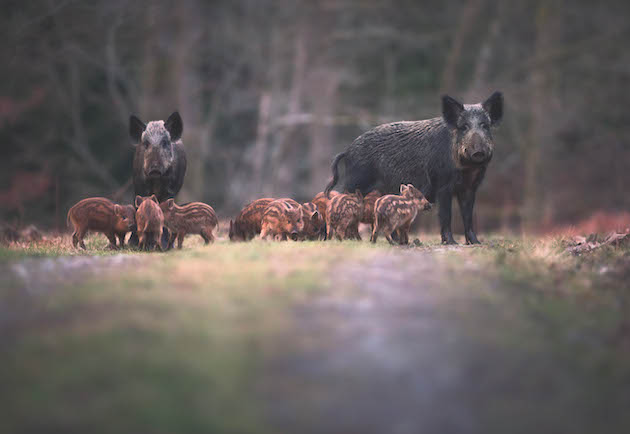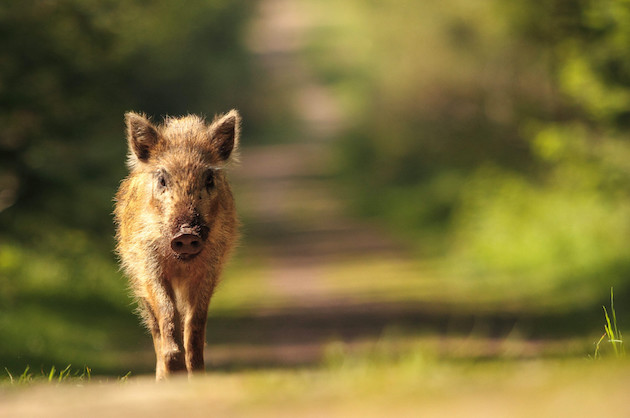Wild boar shooting in the UK
Wild boar shooting in the UK is permitted as boar are legal quarry and currently have no close season —…
The countdown is on for The British Shooting Show – book tickets online today and save on gate price!

During the reign of King William I, the enactment of the Forest Law (1087) laid down that those guilty of killing a stag, roebuck or wild boar were liable to the punishment of blinding, and the hunting of these “beasts of the forest” was reserved only for nobility.
Forest Law was designed to protect game species and the habitat that sustained them, implemented for the sole purpose of protecting game stocks for the king’s personal hunting forays. Originally, royal forests were designated hunting grounds, not limited to afforested areas, but encompassed open heathland, grasslands and wetlands. However, the implementation of the Forest Law led to a monumental push for afforestation, often at the expense of local communities whose homes were burned, entire villages evicted and lands cleared to bolster habitat and consequently increase and sustain deer and boar populations.
The Forest Law was disastrous for many local people but undoubtedly helped to create a healthy and mostly unhindered breeding population of native wild boar. Historical evidence suggests that the original UK natives were most common in coastal areas and in woodland plantations below the snowline. Later, in the Middle Ages, the implications of the feudal system led to the felling of forests and the drainage of reedbeds — both due to the growth in agriculture — which degraded and in some areas removed all suitable habitat for boar.
Wild boar in the UK quickly became villanised for uprooting crops, breaking fences and interbreeding with domestic pigs. The species was caught up in a period of prolonged animal-human conflict and its habitat became increasingly fragmented. By the 16th century, boar were only present in a few areas of small, isolated woodland habitats. It became vulnerable to overhunting, and by the 17th century wild boar had become extinct in the UK.
The last individuals were thought to live in the royal forests of Dean in Gloucestershire and Pickering in Yorkshire. In the early 1980s, the species returned to the UK as the keeping of wild boar in a captive environment became popular with British farmers looking for viable diversification opportunities. Boar were imported from France to be farmed under the licence supplied through the Dangerous Wild Animals Act 1976.
In the following years there were several escapes, as well as some deliberate releases, and wild boar were soon roaming the British countryside. And on 21 October 1998, the Ministry for Agriculture and Fisheries (now Defra) officially confirmed the presence of two free-roaming wild boar populations.
The combined UK population of wild boar and feral pigs is now highly disputed, with estimations varying between 500 and 4,000. These estimates are most likely a gross misrepresentation of the actual population size. The most up-to-date estimate for the largest UK boar population in the Forest of Dean alone is more than 1,170 pigs.
The National Biodiversity Network (NBN) — the UK’s largest partnership for wildlife data — at the time of writing has 582 confirmed records across England, Wales, Scotland and a lone record for Northern Ireland. There are also countless informal reports of boar seen on shoot days and on woodland walks across many areas thought to be boar-free.
Calculating wild boar populations is near impossible, with little known about the true extent of the breeding population. Due to the species’ preferred habitat of thick undergrowth and forested areas, identifying individuals can become difficult. The Forestry Commission has adopted the use of thermal-imaging technology and annual distance sampling surveys, which allow for more accurate population estimates to be taken. Forest Research — the principal organisation for forestry and tree-related research — admits that, due to the difficulties of counting wild boar, the results of these surveys can only ever be an estimation. They are more useful for calculating overall population trends in conjunction with sustained population management.
The UK feral boar populations originate from farm-bred boar, and therefore differ considerably from their truly wild European cousins. As with all farmed domestic stock, productivity is paramount and this is reflected in UK wild boar litter sizes, which average between six and 10 piglets — twice that of their European counterparts. There is also substantial evidence to suggest that some UK wild boar boar are reaching sexual maturity within their first year.

Increased litter sizes and accelerated sexual maturity are key factors that should make UK boar super-colonisers
Increased litter sizes and accelerated sexual maturity are key factors that should make UK boar super-colonisers. Strangely, though, for a species that has been back on British soil for three decades, most thriving populations are primarily localised to their original strongholds. This is most likely due to the family group nature and ecological behaviour of wild pigs. A sow will stay with her young for up to a year before the young males are kicked out from the group, usually prior to the sow having another litter. Young females will stay with the matriarch sow for most if not all of their life. With the young male wild boar removed from the family group, they are more likely to move into new areas in search of a mate. Unless there are other local boar populations nearby, this movement significantly slows the rate of colonisation.
This was highlighted in the findings of the Joint Nature Conservation Committee UK Mammals: Species Status and Population Trends (2005), which showed that unless there was a significant population of boar already in place, numbers were likely to stay relatively static or slowly increase. Using the Forest of Dean as an example, there is no reason why wild boar — which are good swimmers — could not swim across the river Severn and start to spread throughout southern England at a rapid rate. However, with ample forest habitat that could sustain a boar population nine times its current size, there is no reason for boar to venture outside the relative safety of the Forest of Dean area.
Where I live in Dumfries and Galloway, there are two growing unrelated populations of wild boar, one on the Solway coast and another in the north of the region towards the Ayrshire border. These animals are separated by roughly 25 miles of farmland, open hill and commercial forestry. Dumfries and Galloway is the most afforested region in Britain and the continual blocks of monoculture Sitka spruce plantation usually offer little ecological benefits. However, they create a stealth route for colonising species such as boar. In Galloway, lone boar are now appearing on ground many miles from known breeding populations and trail camera footage suggests these are all lone males. If the two separate populations of Galloway boar meet, there is likely to be a faster colonisation of the region, with young males successfully finding mates and settling in new territory.
Looking forward, population of wild boar in the UK is likely to increase in its current strongholds and there will be a slow outward colonisation of surrounding areas, as current populations outgrow and exceed the holding capacity of their occupied habitat. In areas where two or more separate populations are expected to meet, the rate of succession is likely to be much higher, as young males will begin to find mates.
Natural England’s Review of the Population and Conservation Status of British Mammals lists the prospects for wild boar as positive, with an increasing population status, extended range opportunities and a stable habitat.
Wild boar shooting in the UK is permitted as boar are legal quarry and currently have no close season —…
Population management of wild boar in the UK is also likely to play a significant role in their spread. The Forestry Commission initially struggled to carry out an effective wild boar cull. However, by increasing the number of wildlife managers who are capable and equipped for managing boar, forestry ecologists now believe they are able to maintain an acceptable population of boar in areas such as the Forest of Dean. In stronghold areas, a sustainable population of wild boar present on habitat below its ecological carrying capacity will ultimately dictate the rate of colonisation of non-boar-inhabited areas. The overriding factor influencing the spread and colonisation of wild boar in the UK is the unregulated growth in their original strongholds. If the shooting sector and major land management bodies such as the Forestry Commission continue to meet cull targets in strong population areas, we are unlikely to see any major increase in the UK-wide wild boar population. If left unmanaged, the unique breeding patterns of UK boar will allow the species to colonise at an accelerated rate compared with that of their European cousins, but only once their current habitat area has reached its ecological carrying capacity.
Get the latest news delivered direct to your door
Discover the ultimate companion for field sports enthusiasts with Shooting Times & Country Magazine, the UK’s leading weekly publication that has been at the forefront of shooting culture since 1882. Subscribers gain access to expert tips, comprehensive gear reviews, seasonal advice and a vibrant community of like-minded shooters.
Save on shop price when you subscribe with weekly issues featuring in-depth articles on gundog training, exclusive member offers and access to the digital back issue library. A Shooting Times & Country subscription is more than a magazine, don’t just read about the countryside; immerse yourself in its most authoritative and engaging publication.

